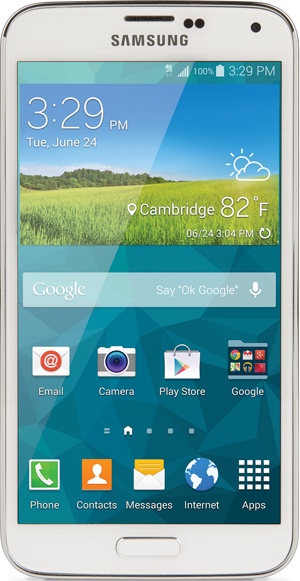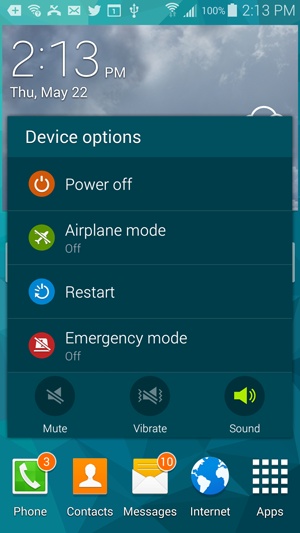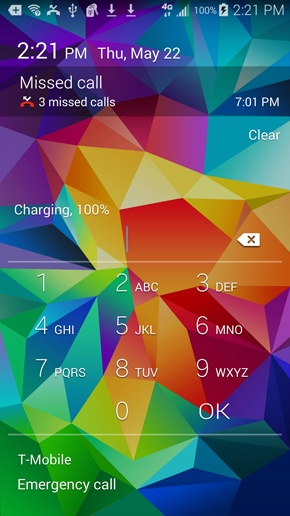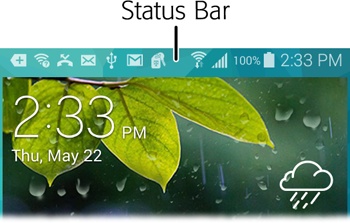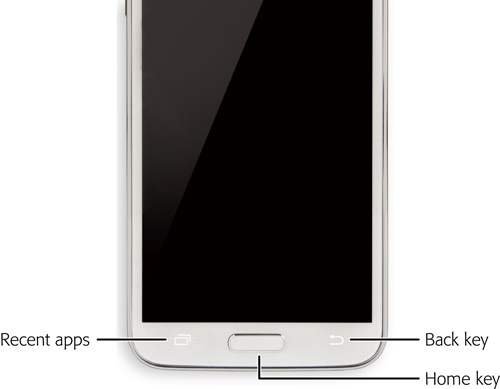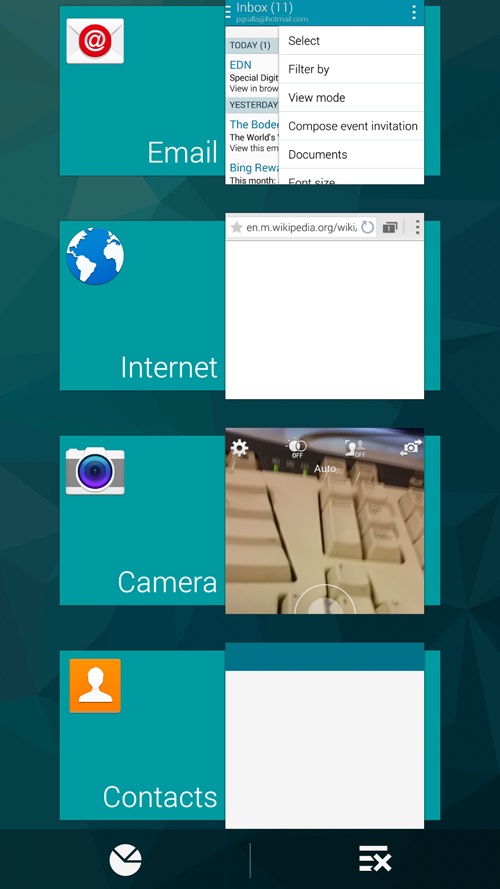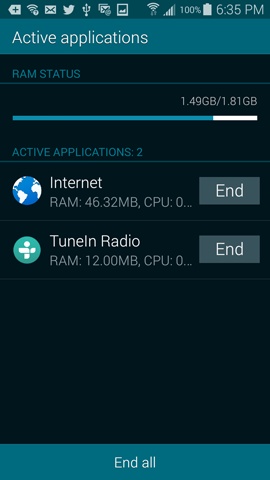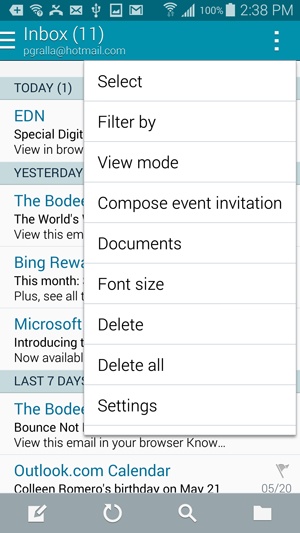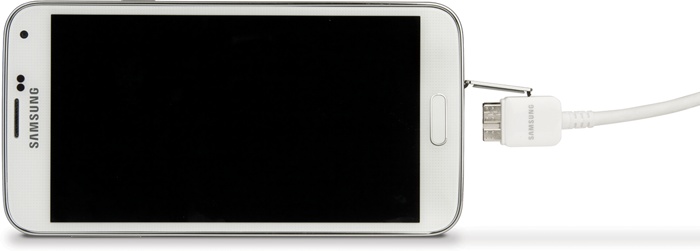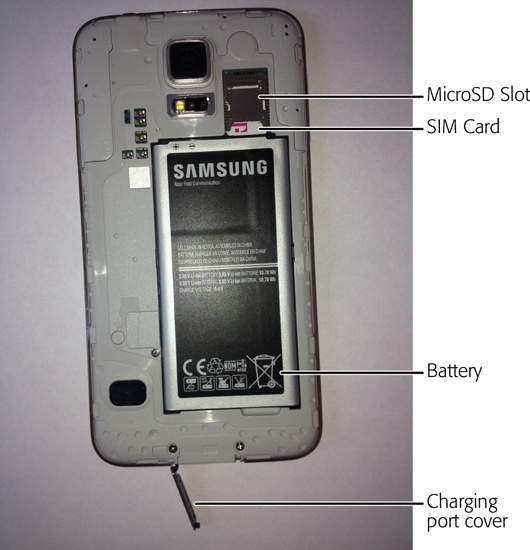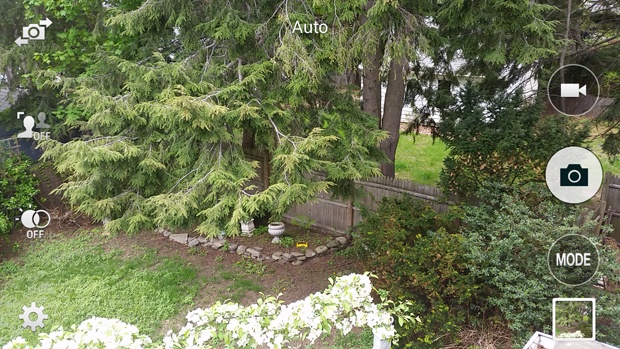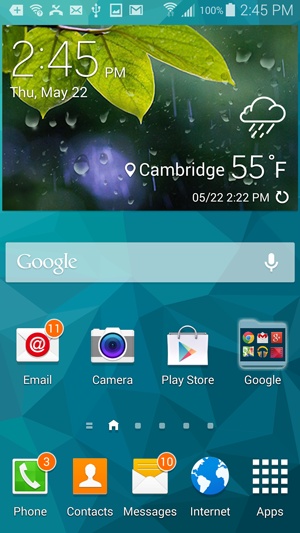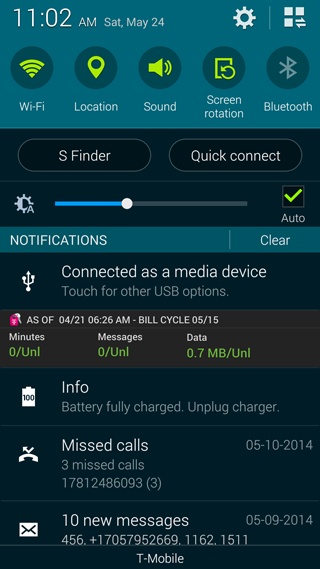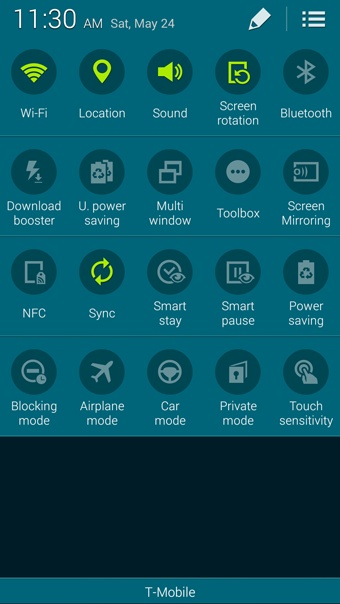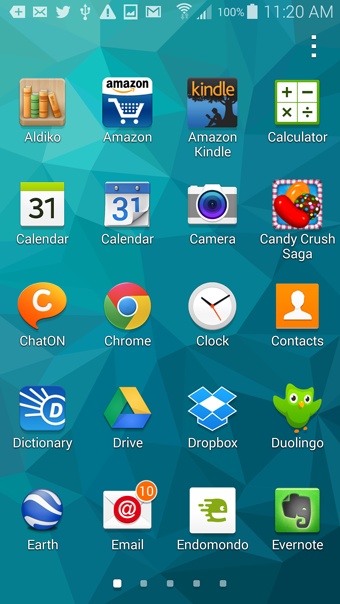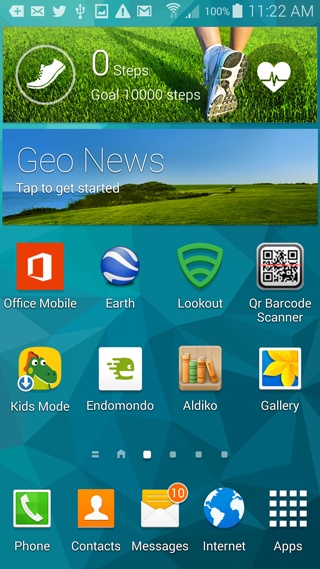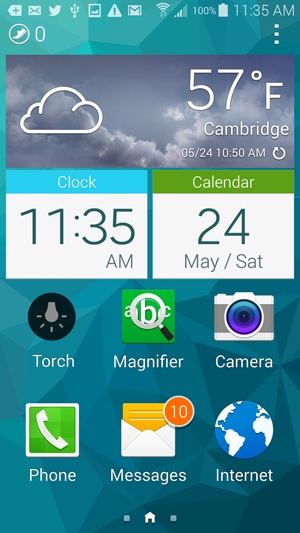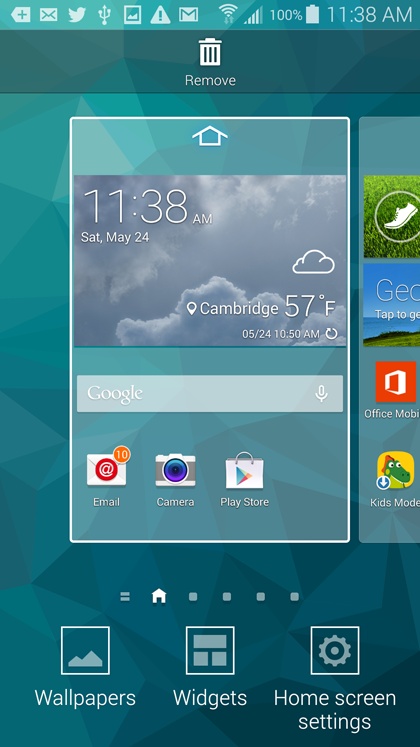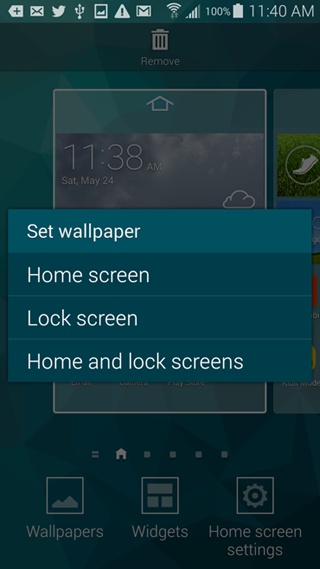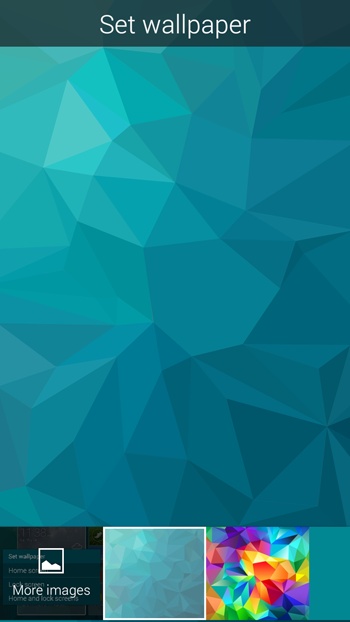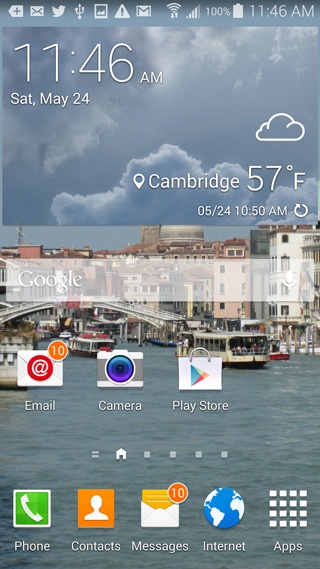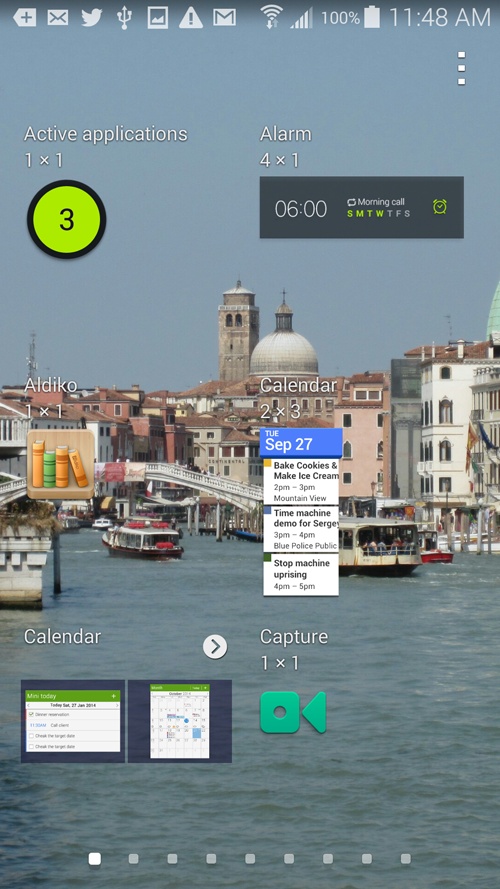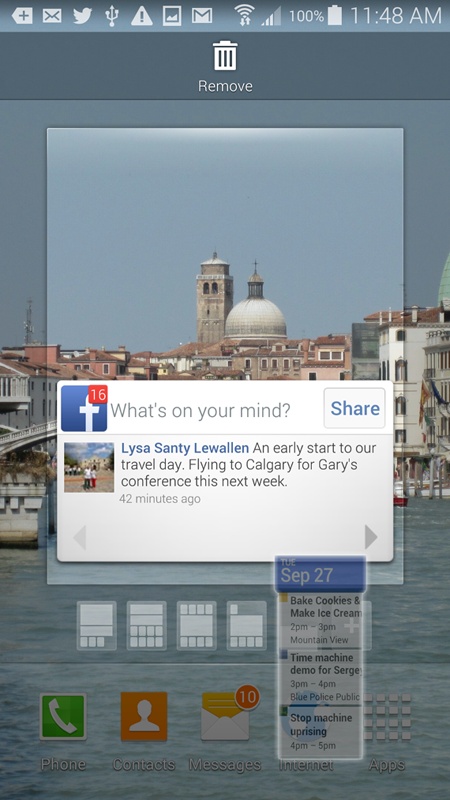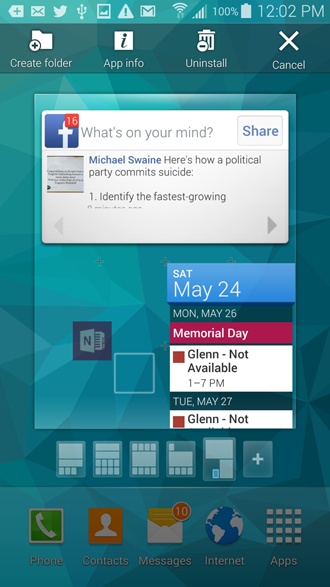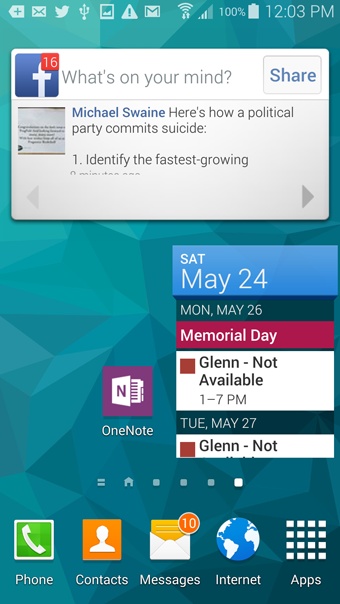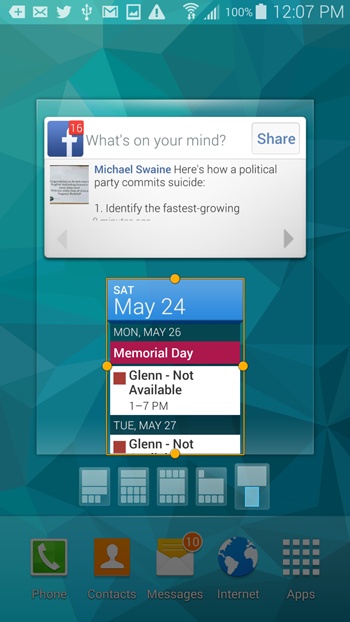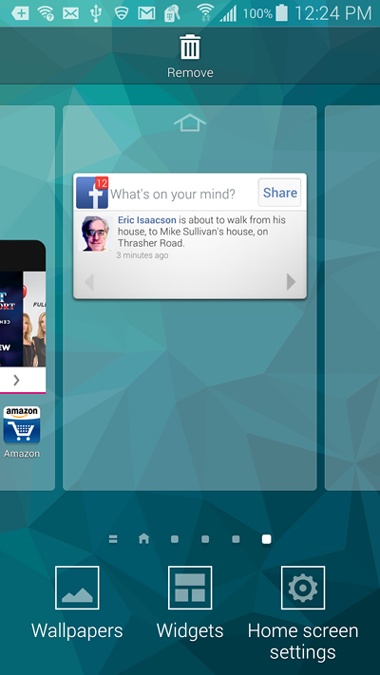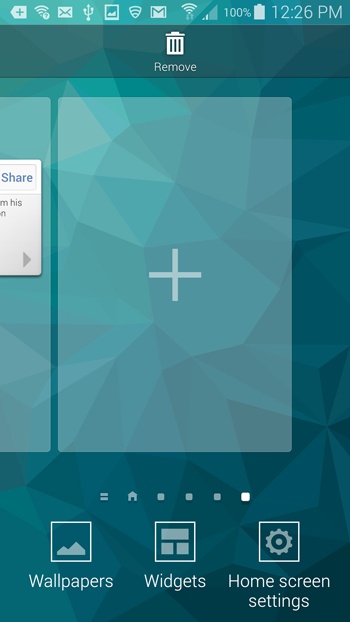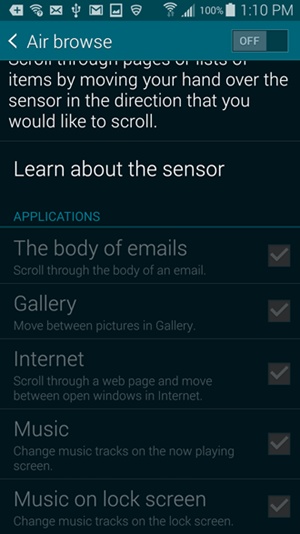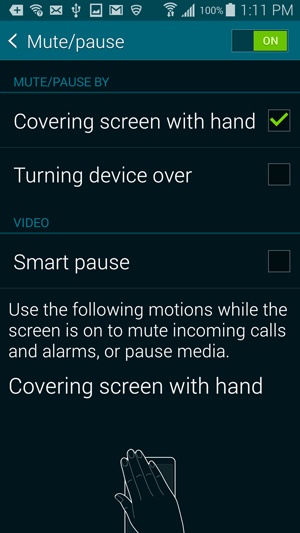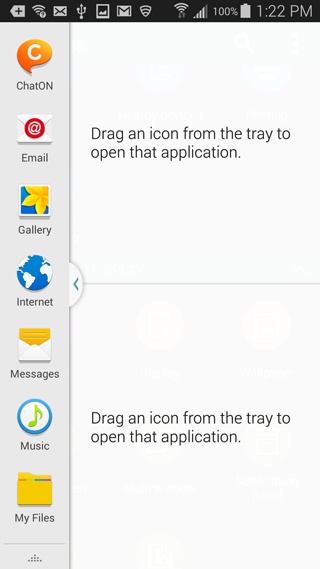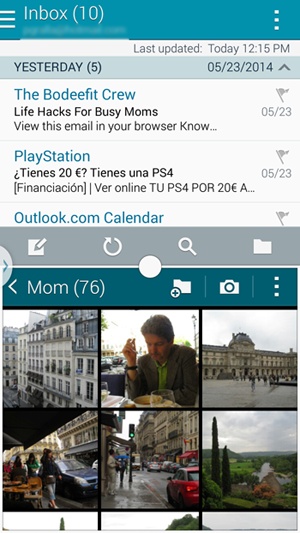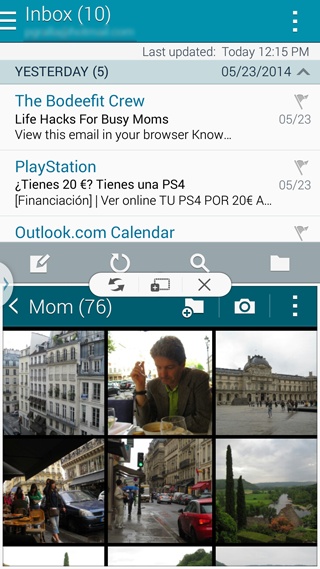Chapter 1. The Guided Tour
Youâll learn to:
Lock and unlock the screen
Add apps and widgets and change wallpaper
Use Easy mode
Replace the battery
Control the S5 by touch and with the magic of gestures
THE SAMSUNG GALAXY S5âa svelte, elegant phoneâis an enticing gadget, and the first time you hold it in your hands, youâll immediately want to put it through its paces: calling friends, browsing the Web, checking your email, and more. As youâll see in the rest of this book, it can do some remarkable things that make you feel as if the phone has superpowers.
To help you unlock all those powers, though, you need a solid understanding of how the Galaxy S5 works and familiarity with all its different parts. Youâll want to know where all its buttons, keys, and ports are located, for exampleânot to mention how to get to your Home screen and panes, and use some of the deviceâs amazing new features, like its ability to let you navigate by merely moving your eyes.
Power/Lock Button
THREE-QUARTERS OF THE WAY up on the right side of the Galaxy S5, youâll find a small, rectangular silver button. It may be only a single button, but itâs a hardworking one, and it performs multiple functions. Press it with your S5 turned off, and the phone springs to life. Press and release it when your S5 is turned on and active, and it puts the phone into Standby mode. If your S5 is turned on, press and hold it to show a screen that lets you do the following:
Airplane mode. In Airplane mode, all wireless communications are switched off, but you can still use the phoneâs apps and other features. Tap this option to enter Airplane mode. If youâre already in Airplane mode, tap again to get out. As the name suggests, Airplane mode is what the cabin crew wants you to turn on while in the air.
Restart. Turns off your S5 and restarts it.
Mute. Turns off all sounds.
Emergency mode. Tap this to use an emergency feature designed to have the S5 automatically alert peopleâby text messageâif you need emergency assistance. It also sends your location information. You need to enable Emergency mode before you can use it.
Vibrate. Turns off vibration. If vibration is turned off, you can turn it back on here.
Sound. If your phone is muted, tap here to turn the sound back on.
Tip
The Power/Lock button also performs a useful trick that people near you will appreciateâit shuts off your ringer when you receive a call. Press it once when you get a call, and your ringer turns off. Youâll be able to see whoâs calling, without the ring, and decide whether to answer the call or ignore it. If you ignore the call, it gets sent to voicemail.
Locking the Screen
When you put the Galaxy S5 on Standby using the Power/Lock button, the screen stops responding to touch. It blacks out, indicating that the screen is locked. Always lock the screen before putting the Galaxy S5 in your pocket or bag to avoid accidental screen taps and potentially embarrassing unintended phone calls. In fact, every time you leave the phone untouched for a certain amount of timeâas little as 15 seconds to as much as 10 minutes (Display)âthe screen automatically locks itself.
While the screen is locked, the Galaxy S5 still operates behind the scenes, checking email and Facebook on schedule. You can still get phone calls and text messages, and even listen to music while the screen is locked.
When you again want to use the Galaxy S5, youâll need to unlock it. Press the Power/Lock button or the Home key. Then put your fingertip on the screen and slide it to the right or left. Your Galaxy S5 is now ready to do your bidding. Youâll get notifications about missed calls, text messages, and so on. If youâve set up a PIN on your phone so that only someone with a password can use it, youâll have to type in the PIN before you can use your phone. (See Multi window for details on how to set up a PIN.)
Tip
You can adjust the amount of time it takes for the Galaxy S5 to lock itself. You can also turn off Locked mode entirely. And for added security, you can also require that a password be used to unlock your S5, or even your own fingerprint. For details, see Multi window.
Headset Jack
AT THE TOP OF the Galaxy S5, youâll find a 3.5-millimeter headset jack. Notice that itâs a headset jack, not just a garden-variety headphone jack. It doesnât just let you listen; it accepts incoming sound as well. Thatâs so you can plug a headset (like an earbud headset) into it and use it for making phone calls.
Of course, itâs also a headphone jack, so you can plug in headphones or even external speakers and enjoy the phone as a music machine, since it also offers full stereo.
About the Screen
THE SCREEN IS WHERE you and the Galaxy S5 do most of your communicating with each other. Compare the Galaxy S5âs screen to that of almost any other phone, and youâll immediately notice how roomy it isâ5.1 inches, measured diagonally (technically, thatâs 1920 x 1080 pixels). Itâs got extremely high resolution (432 pixels per inch, for the techie crowd). When you turn it sideways, it switches to a widescreen TV and movie format.
But thereâs a lot going on behind that pretty display.
Tip
Because youâre going to be touching the display with your fingers, itâs going to get dirty and streaky. Simply wipe it clean with a soft, lint-free cloth or tissue. The screen is scratch-resistant, but if youâre worried about scratches, get a case or screen protector. See Appendix B for ideas.
Built-in Sensors
Underneath its flat black screen, the Galaxy S5 has a whole bunch of sensors that perform a lot of its magic:
Proximity sensor. Have you ever noticed that when youâre talking on your S5, the screen often goes blank? Thatâs thanks to the proximity sensor. It senses when your face is close to it during a phone call and automatically turns off and blanks the touch screen as you keep talking. It does this to save power, and so you donât accidentally touch the screen while talking and perform some unwanted task.
Ambient light sensor. Senses the light level and adjusts your screenâs brightness as a way to save battery power. So in bright light, it makes the screen brighter and easier to see; in dim light, it makes the screen dimmer, since bright light is not needed.
Accelerometer. As its name implies, this sensor measures acceleration and motion. The Galaxy S5 uses the accelerometer to sense the orientation of the screen and turn it to either landscape or portrait mode. But clever app makers use it for other things as well, such as automatic collision notification, which detects when youâre in an accident and then automatically makes a call for assistance for you. Thereâs even an app that works with the phoneâs magnetometer to detect potholes as you drive and create a log about their locations, which you can then email to your local department of public works. (Itâs called Pothole Agent. Search for it on Google Play, as described on Browsing by Category.)
Magnetometer. Measures the strength and direction of the earthâs magnetic field. Itâs used for compass apps and can also work with the accelerometer.
Gyroscope. This motion detector is used for a host of features. For example, the S5 uses the gyroscope in concert with the accelerometer to interpret motion gestures you make and let you operate the phone by waving your hands.
Barometer. Measures the current atmospheric pressure and altitude. The most obvious use is for weather-related apps. But itâs got a lot of other uses as well. For example, when you use an app that measures the number of calories you burn, that app takes the barometric pressure and altitude into account, because you burn a different number of calories based on those readings.
Gesture. This sensor uses infrared light to sense your gestures so that you can control the S5 without touching it. Yes, you read that right. You can control it by waving and other gestures thanks to this sensor. And as youâll see later in this chapter, you can even control scrolling by moving your eyes. (Youâll learn all about these tricks later in this chapter on Flick.)
Fingerprint. Yes, the S5 has a fingerprint sensor. Why? So you can unlock your screen using your fingerprints. (To see how, turn to Multi window.)
Heart Rate. On the back of the S5 near the top of the screen, just below the camera lens, youâll find a heart rate sensor. To use it, turn to S Health.
Hall. This sensor recognizes when the phoneâs cover is closed or open.
Status Bar Icons
THE GALAXY S5 MAKES sure to keep you updated with information about its current status and any news, updates, and information it thinks is important. It does so by displaying a variety of icons in the status bar at the top of the screen. The status bar is divided into two parts. On the right side, youâll find icons that inform you about the current state of the Galaxy S5, such as signal strength, 3G or 4G connection status, the time of day, and so on. At left is the Notification area, which alerts you when you have email or voice messages waiting, when an event on your calendar is about to occur, and more.
Note
Many applications have their own icons that notify you about news, information, and updates. These always appear on the left side of the status bar. Youâll see alert icons from Gmail, Facebook, and others.
Here are the most common icons youâll come across:
Cell signal.
 The more bars you see, the stronger the signal. The stronger the signal, the clearer the call and the lower the likelihood that youâll lose a connection. If you have no connection at all, then instead of this signal, youâll see the much-hated warning: (No service).
The more bars you see, the stronger the signal. The stronger the signal, the clearer the call and the lower the likelihood that youâll lose a connection. If you have no connection at all, then instead of this signal, youâll see the much-hated warning: (No service).Note
When you see a notification on the left side of the status bar, drag down the Notification panel to see more details. You can also act upon the notification by tapping its icon after you drag it downâlike checking your email or running an app that youâve just downloaded. Thereâs also a Clear button that makes all notifications go away.
Roaming.
 If youâre outside your carrierâs service area and connected via another network, youâll see the Roaming icon. Keep in mind that typically youâre charged for making calls or using data when youâre roaming, so when you see this icon, be careful what you do on your Galaxy S5âmaybe itâs not the time to download 30 songs and a half-hour TV show.
If youâre outside your carrierâs service area and connected via another network, youâll see the Roaming icon. Keep in mind that typically youâre charged for making calls or using data when youâre roaming, so when you see this icon, be careful what you do on your Galaxy S5âmaybe itâs not the time to download 30 songs and a half-hour TV show.3G/4G.
 This one appears when youâre connected via 3G or 4G high-speed broadband service, which should be most of the time. It means that download and upload speeds are fast.
This one appears when youâre connected via 3G or 4G high-speed broadband service, which should be most of the time. It means that download and upload speeds are fast.Bluetooth connection.
 This icon indicates that youâve turned on Bluetooth, for making a connection to a headset or some other device.
This icon indicates that youâve turned on Bluetooth, for making a connection to a headset or some other device.Mobile hotspot.
 Your Galaxy S5 can serve as a mobile hotspot, providing Internet service to up to five computers, smartphones, or other devices via WiFi. See Setting Up a Hotspot for details. When you turn the phone into a mobile hotspot, this icon appears.
Your Galaxy S5 can serve as a mobile hotspot, providing Internet service to up to five computers, smartphones, or other devices via WiFi. See Setting Up a Hotspot for details. When you turn the phone into a mobile hotspot, this icon appears.Airplane mode.
 When you use Airplane mode, you turn off WiFi and cellular communications. You can still keep using your phoneâs apps, but it doesnât interfere with navigation equipment.
When you use Airplane mode, you turn off WiFi and cellular communications. You can still keep using your phoneâs apps, but it doesnât interfere with navigation equipment.Downloading.
 When youâre downloading an app or media file, youâll see this icon.
When youâre downloading an app or media file, youâll see this icon.New email message.
 Youâve got mail! See Reading Mail for more about reading new email.
Youâve got mail! See Reading Mail for more about reading new email.Upcoming event.
 Now youâll never forget your anniversaryâor your dentist appointment. The Galaxy S5 alerts you via this icon when youâve got an event about to happen.
Now youâll never forget your anniversaryâor your dentist appointment. The Galaxy S5 alerts you via this icon when youâve got an event about to happen.Voicemail message.
 Youâve got mailâvoicemail, that is. (See Voicemail to learn how to check your voicemail.)
Youâve got mailâvoicemail, that is. (See Voicemail to learn how to check your voicemail.)Missed call.
 Someone called you, and you didnât answer. You see this icon appear even if the person left no voicemail.
Someone called you, and you didnât answer. You see this icon appear even if the person left no voicemail.Vibrate.
 This symbol indicates that youâve set your Galaxy S5 to vibrate when you get a call.
This symbol indicates that youâve set your Galaxy S5 to vibrate when you get a call.TTY symbol.
 Youâve turned on Teletypewriter mode, a special mode that lets the Galaxy S5 communicate with a teletypewriter. Thatâs a machine that deaf people use to conduct phone calls by reading and typing text.
Youâve turned on Teletypewriter mode, a special mode that lets the Galaxy S5 communicate with a teletypewriter. Thatâs a machine that deaf people use to conduct phone calls by reading and typing text.Alarm.
 Who needs an alarm clock when youâve got your Galaxy S5? This icon indicates that the alarm is on. You can even set multiple alarms.
Who needs an alarm clock when youâve got your Galaxy S5? This icon indicates that the alarm is on. You can even set multiple alarms.Battery.
 Get to know this iconâit shows you how much battery life youâve got left. When the battery is charging, you see a battery-filling animation and a tiny lightning bolt.
Get to know this iconâit shows you how much battery life youâve got left. When the battery is charging, you see a battery-filling animation and a tiny lightning bolt.Connected to VPN.
 If you use your Galaxy S5 to connect to your company network via virtual private networking (VPN), this icon shows when your connection is active. You can check your work email and do anything else your company lets VPNers do. (If youâre interested in getting VPN access, youâll need your IT departmentâs help, as described in Chapter 14.)
If you use your Galaxy S5 to connect to your company network via virtual private networking (VPN), this icon shows when your connection is active. You can check your work email and do anything else your company lets VPNers do. (If youâre interested in getting VPN access, youâll need your IT departmentâs help, as described in Chapter 14.)Disconnected from VPN. You were on the VPN, and now youâre off.
USB connection.
 Youâll connect your phone to your computer via a USB cable for a variety of reasons, including copying and syncing files (Chapter 13). Hereâs the icon youâll see when you make the connection.
Youâll connect your phone to your computer via a USB cable for a variety of reasons, including copying and syncing files (Chapter 13). Hereâs the icon youâll see when you make the connection.SD card is full.
 This icon appears when your SD card (MicroSD Card) has run out of space. Itâs time to get a bigger or newer one, or start deleting files.
This icon appears when your SD card (MicroSD Card) has run out of space. Itâs time to get a bigger or newer one, or start deleting files.Smart scroll.
 This icon appears when youâre using the S5âs amazing Smart scroll feature, which lets you scroll through pages by moving your eyes. To turn it on, tap the Settings app on the Apps screen and select AccessibilityââDexterity and interactionâ and turn the Smart scroll setting to on.
This icon appears when youâre using the S5âs amazing Smart scroll feature, which lets you scroll through pages by moving your eyes. To turn it on, tap the Settings app on the Apps screen and select AccessibilityââDexterity and interactionâ and turn the Smart scroll setting to on.
The Three Keys
Most of the time you use your Galaxy S5, youâll be tapping virtual buttons on the keyboard. But down at the bottom of the Galaxy S5, there are three keys: one fat, white physical one in the middle, and two virtual ones (touch keys) that light up only when you touch them. From left to right, hereâs what they do.
Tip
Donât like the elusive behavior of the touch keys? You can make them visible all the time by changing the setting. See Wallpaper.
Recent Apps
Tap this button and youâll see a list of the apps that youâve most recently run, including currently running ones. Scroll up and down through them, and then tap the one you want to jump to.
Look toward the bottom of the screen at the two iconsâthe pie icon on the left, and the icon with an X on it (End All) on the right. Tap the pie icon and youâll see a list of all the currently active apps. Up at the top of the screen, youâll see how much total RAM you have on your S5 and how much youâre currently using. That way you can see whether youâre running out of memory, and if you are, shut down an app or two. To shut down an app, tap the End button to its right. To kill them all, tap âEnd all.â
Home Key
Repeat after me, Dorothy: Thereâs no place like home, thereâs no place like home⦠Wherever you are on the Galaxy S5, press the Home key and youâll come back to the familiar Home screen. You wonât even need to tap your ruby slippers together. But thereâs more the Home key can do as well. Hold it down, and youâll launch an app called Google Now, which is a kind of personal assistant that gives you all kinds of advice, such as what route to take home from work to avoid traffic. See Using Google Now for details.
Multipurpose Jack and Charger
FOR TRANSFERRING FILES AND syncing music and movies between your computer and the Galaxy S5, thereâs a multipurpose jack at the bottom of the phone. It normally has a small silver cover, so to get to the jack, flick it open. The multipurpose jack is composed of two small portsâa micro-USB port on the right and a smaller one to its left. The S5 comes with a special cable that connects to both ports on one end and plugs into a USB port on the other end. You can use that special cable with your S5, or just use a normal USB cable with a micro-USB connection.
If youâre simply looking to connect your S5 to a PC or Mac to transfer files, you can get by with just a normal USB cable with one end for a micro-USB port. Just plug the cable into your S5 and the other end to a USB port on a PC or Mac, as described on Connecting Your Galaxy S5 to Your Computer. However, you donât have to buy a USB cable if you donât have oneâyou can do the same thing with the S5âs own special cable.
So whatâs the point of having a multipurpose port rather than a normal USB one? With the multipurpose port and cable, you can charge your phone more quickly. Plug the multipurpose cable into the port, and then plug the other end into the USB charger that comes with the S5, and your phone gets charged even faster.
If you use power-hungry features like video and GPS, you may have to charge the S5 every night. If you stick to mostly phone calls and text messages, you may be able to get by with charging only two or three times a week.
Tip
You can use the Galaxy S5 while itâs charging, unless the battery has run down completely. In that case, itâll need to build up a charge before you can turn it on.
This port does one more thing as well. The S5 may be small enough to fit in the palm of your hand, but itâs still a big-time entertainment machine. Thatâs because itâs HDMI (High-Definition Multimedia Interface) capable. With it, you can view videos and photos taken on your Galaxy S5 right on your computer or TV screenâas long as they also have HDMI ports. Plug one end of the cable into your Galaxy S5, the other into your PC or TV, and youâre ready to go. What does that have to do with the USB port? Plenty: You can buy a special attachment to connect your phone to an HDMI device. See Playing S5 Video on Your TV for details.
Tip
When you connect your Galaxy S5 to a PC for the first time, your PC may not recognize it. Thatâs because your PC may need special drivers (small pieces of software) to communicate with the Galaxy S5. Windows will try its mightiest to find the drivers, but thereâs a chance it wonât be able to locate them. If it doesnât, you can go over to the Samsung help website (www.samsung.com/us/support/) and search for Samsung Galaxy S5 drivers. Then download the drivers and follow the instructions for installing them.
Ringer Volume
IS YOUR RINGER TOO loud? Too soft? Get it just right by using this long silver key on the S5âs upper left. Press the top part to make the volume louder and the bottom one to make it softer. When you press, a ringer volume app pops up on your screen, showing you how much louder or softer youâre making the ring.
Microphone
THAT TINY LITTLE HOLE at the bottom of the Galaxy S5 is the microphone. Yes, itâs small, but it does the job very nicely.
Battery
THE GALAXY S5 HAS a battery cover. Yes, thatâs right, an actual battery coverâyou can remove the battery and replace it with a new one, unlike some other cellphones. To remove the battery, flip the S5 over, put your finger underneath the small plastic slot on the upper left, and pull off the battery cover. Youâll see the battery, which you can easily remove by putting your finger into the slot at the bottom and gently pulling up. Donât pull it hard or yank it.
Note
Before removing the battery, make sure to turn the Galaxy S5âs power off via the Power/Lock key.
To replace the battery, simply put it back into place and then replace the battery cover. Now turn the phone back on.
SIM Card
DEPENDING ON YOUR CARRIER, you may need a SIM card to use your phone. If so, youâll get the SIM card when you buy the phone. The carrier may put it in for you, or you may need to do it yourself. Itâs located above the battery, and youâll have to remove the battery to get to it. When you insert it, make sure the gold-colored contacts face down.
MicroSD Card
ATOP THE SIM CARD, youâll find a small slot for the microSD card. Itâs about the size of a fingernailâand much smaller than the normal SD memory cards used in cameras. Your Galaxy S5 may not have come with an SD card, so you may have to buy one. The S5 can use any SD cards that store up to 128 GB of data. Place the card in the slot with the arrow facing in. Youâll hear a click when itâs in place. After that, replace the battery cover.
After you install the card and turn on the phone, youâll see a notification that the S5 is preparing the microSD card for your use. When itâs done, go to the Home screen, tap the Apps icon at lower right, and then tap SettingsâStorage. Youâll find a new group of settings under âSD card,â listing information like how much total space is on the SD card and how much space remains. (If that information doesnât appear, it means that your SD card hasnât been formatted properly. Thereâs a simple solution: tap âMount SD card.â If your phone doesnât recognize it after that, then tap âFormat SD card.â That should do the trick.)
Warning
If youâve got a microSD card in your phone and youâve stored files on it, make sure not to tap âFormat SD card.â When you do that, you erase all the data stored on it.
If you want to replace the SD cardâfor example, if you have a 16 GB card and want to replace it with one that has more capacityâitâs easy. Return to the Storage settings and tap âUnmount SD cardâ in the SD card section.
When youâve done that, turn off the phoneâs power and remove the battery cover. You can then slide out the microSD card. Then insert a new microSD card and follow the instructions in this section for telling your Galaxy S5 to recognize it.
Camera
YOUR SAMSUNG GALAXY S5 includes not one but two cameras, both capable of taking videos as well as photos. The camera on the back, which is the one youâll normally use for taking photos and videos, has a whopping 16-megapixel resolution. The camera that faces you is for video calling and video chat, although youâll probably take your share of selfies as well. Itâs got a 2-megapixel resolution. Donât look for a physical camera button for taking photos; instead, you tap an onscreen button (Taking Still Photos).
Water-Resistant Case
THE S5âS EXTERIOR LOOKS like just any other smartphoneâs, although maybe a little snazzier. But its beauty is more than just skin deep. Its case is water-resistant and dust-resistant. That means itâs less likely to go on the fritz if you splash it when youâre washing your hands, or even if you drop it into a lake, pond, or some more unpleasant watery environment.
Keep in mind, though, that itâs not waterproof. So you canât use it for taking photos when scuba diving, for example. To avoid water damage, keep the following in mind:
Donât put it in water more than a meter deep or submerge it in any water for more than 30 minutes.
Make sure that the case is tightly closed after you open it to access the battery, SIM card, or microSD card. Also, make sure that the multipurpose jackâs cover is closed tightly as well.
Donât expose the S5 to soapy water, salt water, or ionized water.
If you drop the S5, or if it receives an impact of some sort, make sure the cases and covers are still tightly sealed.
Samsung and Google Accounts
TO ENJOY ALL THE services your Galaxy S5 is capable of delivering, you need to have a Google account, and possibly a Samsung account as well. On your smartphone, an account is a central location for managing all the services you can get. The Google one is absolutely necessary, but you may want to set up a Samsung one as well. This section tells you what you need to know about each.
Google Account
In order to use your S5, you need a Google account. Thatâs because the S5âs underlying software is made by Google and uses many Google services, such as Maps, Gmail, and more. If you already have a Google accountâif youâve ever used Gmail, for exampleâgreat! You can use that account and all the information and settings youâve stored in it. Or you can create a new Google account when you sign into your S5 for the first time and start fresh.
When you first start your phone, it prompts you to walk through logging into your account or setting up a new one. After that, if you want to make changes, you can head to one central location. At the Home screen, tap the Apps icon, and then choose SettingsâAccountsâGoogle.
Samsung Account
If youâd like to use additional Samsung services, you can also set up a Samsung account. Otherwise, you donât need it. Depending on your carrier, you may be prompted to create a Samsung account or to log into an existing one when you first set up your phone, right after you log into or create a Google account. But if not, you can create one afterward. At the Home screen, tap the Apps icon, choose SettingsâAccountsâAdd Account, and follow the prompts. To change settings, at the Home screen, tap the Apps icon and then choose SettingsâAccountsâSamsung Account.
Home Screen
WELCOME TO YOUR NEW home, the Galaxy S5 Home screen. Get to it by pressing the Home key no matter where you are.
Note
What you see on the Home screen and panes may differ somewhat from what you see here. Cellphone carriers often customize them, put their own apps on them, and sometimes even change them over time.
The screen is chock-full of useful stuff, populated by the following:
Status bar. As detailed on Status Bar Icons, this bar displays the status of many phone features and a variety of notifications in the notification area, like when youâve got email waiting for you.
Notification area. The Notification area takes up the left side of the Status bar, and itâs where youâll get most of your messages from your phone and apps.
App icons. The Home screen has a number of icons on it, for checking email (right on the icon, you see how many new messages youâve got), for using the camera, and one, called Play Store, to let you search for and download new appsâtens of thousands of them, many of them free. As youâll see later in this section, you can add or delete icons from the Home screen.
Dock. Just below the app icons is a row of five icons. They sit in an area called the Dock, and theyâre different from the app icons. Like the app icons, you can move or delete themâexcept for the Apps icon. As youâll see in a little bit, there are other screens you can move to, called panes or panels, but the icons in the Dock stay in place no matter which pane you visit. (The app icons change according to what pane youâre on.) The Phone icon launches the Phone app; the Contacts icon shows you your contacts; the Messages icon lets you send and receive text messages (it shows how many messages youâve got waiting); the Internet icon launches your web browser; and the Apps icon reveals a whole new screen called the Apps screen, filled with apps, apps, and more apps.
Pane indicator. Just above the Dock youâll see six small icons, the most noticeable of which is an icon of a houseâthe Home screen. To its left is an icon of two horizontal lines. That launches My Magazine, a nifty Samsung app for reading articles from the Web (Using My Magazine). To the right of the Home icon are four rectangles, each of which represents a different panel. The brightest rectangle indicates which pane youâre currently viewing. To jump to any pane, tap its button (or slide your finger across the screen).
Above the icons youâll find widgetsâa text input box for searching Google, a weather widget that shows you the current weather, and, above that, the date and the time.
Notification and Quick Settings Panel
Drag down the Status bar, and youâll display the Notification and Quick Settings panel. It displays all of your notification messages and also gives you access to changing the S5âs most common settings, such as for WiFi, Bluetooth, sound, and so on. The quick settings are at the top of the screen; just tap the icon of the one you want to use. There are more than you see thereâswipe to access them. If you prefer, tap the icon all the way on the right, and youâll see a neat grid of many settings. To get access to all of your settings, tap the gear icon at the top of the screen. For details on all of the Galaxy S5âs settings, see Chapter 16.
Tap any notification and youâll see more details about it, such as information about missed calls, Facebook notifications, and files youâve downloaded.
Apps Screen
Tap the Apps icon, and up pops the Apps screen, which includes all the Galaxy S5âs preinstalled applications, plus any apps that youâve installed. Thereâs more than can fit on one screen, so swipe your finger to the right to get to another screenful. You can also tap one of the square icons at the bottom of the screen to move from screen to screen. Tap any icon to run the app.
Tip
If you get bored swiping through the Apps screens to find the one you want, you can make it easier for yourself. Press the Menu icon and select âView as,â and you can rearrange the app icons in alphabetical order, or create a custom arrangement. (Select Custom and press the menu key again to see your options.)
The Panes
What you see on the four panes to the right of the Home screen varies according to your carrierâand what Samsung put there before you bought the phone. You may well see things onscreen that arenât covered in this section.
In general, though, youâll find apps and widgets that perform plenty of common and not-so-common things, like checking your calendar and weather, seeing what your friends are up to on Facebook and other social networking sites, playing music and videos, and more.
To get to another pane, slide your finger to the left or right on the Home screen, and you move from the Home screen to one of the panes. Whatâs on the pane changesâyouâll generally see a mix of app icons and widgets. If you donât like what you see on any pane, donât worry; as youâll see on Easy Mode and Standard Mode, you can fiddle with it to your heartâs content. (The Dock, however, remains the same no matter where you go.) The pane indicator has changedâa different button now shines brighter, to show you which pane youâre on.
Easy Mode and Standard Mode
WHEN IT COMES TO the basic layout of your Home screen, youâve got two choices: Standard mode and Easy mode. In Standard mode, you see the normal Home screen layout described so far in this chapter, with all its widgets and apps. But maybe you donât want to see all those widgets and apps. Maybe you want something simpler, with big, easy-to-see icons and a big font. In that case, you want Easy mode. On the Home screen, tap the Apps icon, and then select SettingsââEasy mode.â On the screen that appears, choose âEasy modeâ to switch to it. If you want, you can also select which apps you want to appear on your Home screen and panes. Out of the box, you see them all. To switch back to the normal Home screen, tap the Apps icon and select SettingsââStandard mode.â
Customizing the Home Screen and Panes
HEREâS ONE OF THE many nice things about the Galaxy S5âitâs easy to put your personal mark on it. Wish there were different apps on the Home screen? No problem; you can easily add them. Want to change the location of apps, or move around widgets and add new ones to each of your panes and the Home screen? Itâs a breeze. The rest of this section shows you how.
Adding Widgets and Wallpaper
The Home screen and all its panes are much like a prepared canvas, waiting for your Picasso-like touches. Instead of paint, you can add widgets and wallpaper.
To do any of the above, the first step is the same: Press and hold your finger anywhere on the Home screen or a pane. Your current pane shrinks and gets outlined, and below it youâll see three options: Wallpapers, Widgets, and âHome screen settings.â Hereâs what to do with each.
Note
The Home screen and panes have limited real estateâthereâs only so much you can put on them. In fact, when the phone is factory fresh, the Home screen and panes may already be full. If you try to put something new on them, like an app or a widget, the S5 wonât let you do it. Nothing happens when you hold your finger on the screen or pane. In that case, you have two options: delete apps or widgets (Deleting and Moving) or create a new pane (Adding and Deleting Panes).
Wallpapers
Hereâs where the Picasso part comes in. You can add a wallpaper image to the background of your Home screen, just like adding wallpaper to your computer desktop. When you tap this option, youâre asked whether you want to set wallpaper for your Home screen, Lock screen, or both.
Make your selection. When you do, youâll see representations of wallpapers you can use at the bottom of the screen. Swipe until you find one you want, tap it, and then tap âSet wallpaper.â Youâve got new wallpaper.
But what if you find Samsungâs selections dull and uninspiring? No problemâtap the âMore imagesâ icon on the bottom left of the screen, and you can use your own fabulous photos and pictures. After you tap, you choose where you want to grab a picture fromâthe Gallery on your S5, a cloud-based service such as Dropbox, or any others youâve got on your S5. For example, say you want to take a photo from the Gallery, so you tap that choice.
The Gallery launches. Navigate until you get to the photo you want to use (for more detail on using the Gallery, see Opening the Gallery.
Note
When you add wallpaper to your Home screen, it also shows up as the background on all your panes. And when you add it to a pane, it shows up on your Home screen.
If you select a picture from the Gallery, you can crop the photo to fit the screen. The S5 suggests a crop for you. You can change it by moving any of the squares that define the crop. Make your selection, tap Done, and youâll see only the cropped area fill your screen.
Widgets
This option lets you add widgets to your Home screen or any pane. A widget is an applet that performs a small, specific task, often grabbing and displaying information from the Galaxy S5 or the Web. When you select this option, you see a list of widgets you can use. Swipe to see more widgets if there are more than can fit on one screen.
The same holds true for widgets. Tap the Widgets tab, hold your finger on the widget you want to add, and drag and drop it where you want it to be. If the pane youâre adding it to is full of icons and widgets, you wonât be able to add more. The Home screen usually fills up first, so consider adding the widget to a different pane.
Home screen settings
Tap this, and you wonât get much to choose from. You can select the transition effect your Home screen and panes use, and turn My Magazine (Chapter 15) on or off. If you uncheck the box next to My Magazine, its pane disappears.
Adding Apps and Folders to the Home Screen
You can also add apps to the Home screen. To do it, tap the Apps icon to get to the Apps screen. Then drag the appâs icon to the pane where you want it to appear and drop it there.
Note
When you add an app to your Home screen or a pane, youâre not actually moving that app to the screen or pane. Instead, youâre adding a shortcut to the app, and thatâs a good thing. When you tap the shortcut, you run the app, just as if you had tapped it in the Apps screen. But thereâs a difference: If you delete a shortcut on the Home screen or a pane, you donât delete the app itself. It still lives on. But, if you delete the app from the Apps screen, it disappears from your S5.
Deleting and Moving
Once youâve added widgets, folders, and shortcuts to your Home screen, youâre not stuck with them, or with where youâve placed them:
To move a widget or shortcut to an app, hold your finger on it for a second or two. The pane or Home screen gets outlined, and a small highlight box appears around the widget, folder, or shortcut. Drag it to its new location and take your finger off. Thatâs where itâll stay. You can even drag it to another paneâjust move toward that edge of the screen. Some widgets can be resized as well. If so, small handles will appear on its outline. Move the handles until the widget is the size you want.
To delete a widget or app shortcut, again hold your finger on it for a second or two until the highlight box appears. Youâll notice a Delete icon in the shape of a trash can at the top of the screen. Drag the doomed item to the trash can. When you see it turn red, release itâitâs gone.
Adding and Deleting Panes
Say youâve got a pane tricked out with widgets, shortcuts, and folders. You decide that youâd like it all to goâevery widget, every shortcut, every folder. Rather than deleting them one by one, you want to delete them in one fell swoop. Just delete the entire pane. So, for example, if you had the Home screen and six panes, youâd end up with the Home screen and just five panes. Fear notâyou can always add a new pane back.
To delete a pane, when youâre on the Home screen or a pane, hold your finger on an empty area of it. Then drag the current pane to the trash can icon at the top of the screen. Voilà âitâs a pane no more.
To add a pane, hold your finger on an empty area of the Home screen or pane. Then swipe to the right past your final pane. There will be a big empty pane with a + sign on it. Tap the + sign. Youâve just created a new pane.
Controlling the Galaxy S5 with Your Fingers
WITH THE GALAXY S5, your fingers do the walking. They do all the work that you do on a computer with a mouse or keyboard. Here are the eight finger strokes you can use on the phoneâs screen.
Tap
Tapping is as basic to the S5 as clicking is to a mouse. This simple gesture is how you press onscreen buttons, place the cursor for text entry, and choose from menus. Note thatâs a finger tap; the screen is designed to detect a fleshy fingertip, not a stylus.
Touch and Hold
Touch an object and hold it for several seconds, and depending on what youâre holding, an option menu may appear. For example, when you touch and hold the Home screen, a menu appears that lets you add an object such as a widget, change your wallpaper, and so on. You also touch and hold an object as a way to grab onto it if you want to drag the object somewhere.
Drag
After youâve grabbed something, you can drag it with your fingerâlike dragging an icon to the Trash.
Slide
Slide your finger across the screen to perform some specific tasks, like unlocking your phone after itâs been put into Standby mode, or answering a call if the phone is locked. Youâll also use the sliding motion to move through all five panes.
Flick
Think of the flick as a faster slide, done vertically when scrolling through a list, like your contacts list. The faster you make the flicking motion, the faster your screen scrollsâsometimes too fast. You can stop the motion, though, by touching the screen again.
Note
Flicks seem to actually obey the laws of physics, or at least as much as virtual movement can. When you flick a list, it starts off scrolling very quickly, and then gradually slows down, as if it were a wheel set in motion that gradually loses momentum.
To scroll through large lists quickly, you can flick multiple times.
Pinch and Spread
In many apps, such as Google Maps, Mail, Browser, and the Gallery, you can zoom in by spreading your fingersâplacing your thumb and forefinger on the screen and spreading them apart. The amount you spread your fingers will determine the amount you zoom in.
To zoom out, put your thumb and forefinger on the screen and pinch them together. The more you pinch, the more you zoom out.
The Magic of the S5âs Gestures
LOOK MA, NO HANDS! No longer is that only the cry of a child showing off riding a bicycle without touching the handlebars. You can do the same thing with your S5. Amazingly enough, you can control it by just moving your hands without touching the screen.
To get to many of the S5âs magic motion features, tap the Settings icon on the Apps screen, and then tap Motions and gestures. Youâll want to try several features you find there.
Air Browse
Turn on Air Browse, and you can scroll through lists and other content such as the body of an email just by moving your hand over the screen in the direction you want to scroll. Once you turn it on, you can customize which apps it works with, such as email, the Gallery, the Web, and Music.
Direct Call
With this magical setting turned on, you can call someone whose message or contact details are currently on the screen, simply by bringing the S5 close to your ear.
Mute/Pause
This one mutes or pauses music or a call when you cover the screen with your hand, or turn the device over. On the same screen, you can turn on âSmart pause,â which is a remarkable feature that detects when youâre watching video, and will pause it when you look away from the screen.
Air View
This feature, which originated on the Samsung Galaxy Note II, lets you hover your finger over the S5 to get information from it. For example, hovering over a web page magnifies it, hovering over a picture in the Gallery opens it, hovering over a Calendar event reveals more details about it, hovering over a truncated text message reveals the full message, and so on.
To turn on Air View, see the full list of what you can do, and customize it, tap the Settings icon on the Apps screen, and then tap âAir view.â Slide the âAir viewâ button to On or Off.
Using Multi Window
MULTI WINDOW IS AN S5 feature you could easily missâbut donât. It lets you do more than one thing on the phone at the same time. For example, watch a video while youâre also checking your email. What could be handier?
To turn it on, on the Apps screen, tap Settings and select âMulti window.â Then, when youâre doing something, like browsing the Gallery or viewing a photo, press and hold the Back key, or else slide the arrow on the left side of the screen to the right. A menu appears down the right-hand side of the screen, with icons for a variety of apps: web browser, email, text messaging, and so on.
Drag the icon of the app you want to use (in addition to the one youâre currently using) to a portion of the screen and then drop it there. The second app opens, so you have two apps open on your screen simultaneously.
Drag the separator between the two windows to change the relative size of each app onscreen. Hold down the separator and then release your finger, and youâll display a set of Multi Window controls. They let you switch the relative position of the windows, make one of the windows full screen, or close down either of them.
Get Galaxy S5: The Missing Manual now with the O’Reilly learning platform.
O’Reilly members experience books, live events, courses curated by job role, and more from O’Reilly and nearly 200 top publishers.
